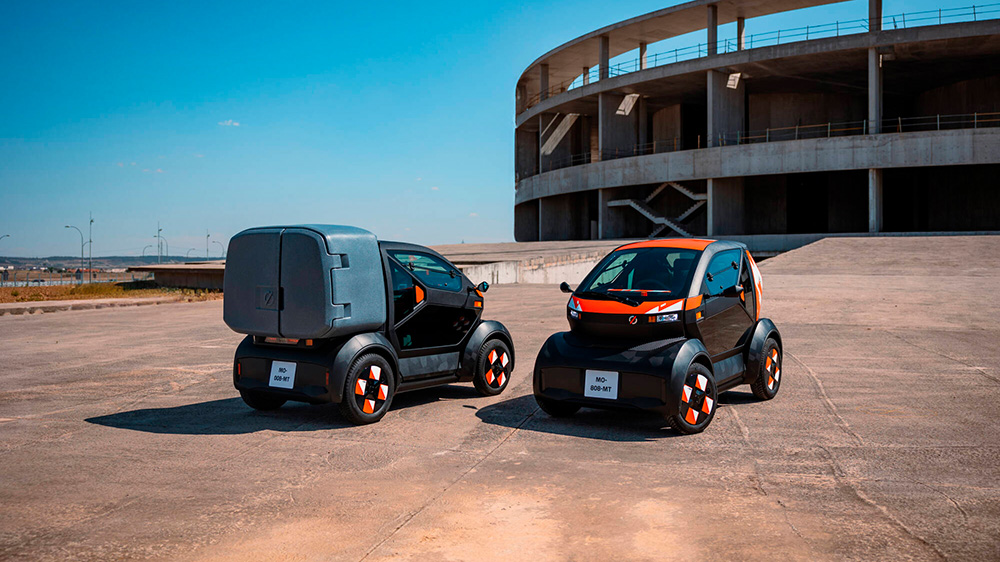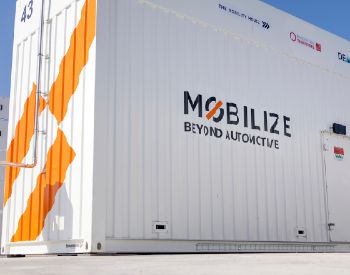The battery is known for powering our electric and plug-in hybrid vehicles. But did you know that these wonderful little objects can do much more than that? Did you know that batteries could be reborn, outside of vehicles, and bring energy to everyone?
Roch Drozdowski-Strehl, Managing Director of the Institut Photovoltaïque of Île-de-France, and Yasmine Assef, Performance Director of the Energy Department at Mobilize, take you on a journey to discover the immense potential of stationary storage!
Talk with Roch Drozdowski-Streh, CEO of the Institut Photovoltaïque of Île-de-France:
WE WILL TALK ABOUT MOBILITY BUT BEFORE THAT, ACCORDING TO YOU, WHERE ARE WE TODAY IN THE ENERGY TRANSITION?
First of all, thank you for your invitation. It would be useful indeed to begin our discussion by defining what the energy transition is. We are at a key moment in our history, and in the public debate on energy and climate, as we are defining our strategy to get out of fossil fuels. We aim to reach carbon neutrality by 2050 as per the Paris Agreement objectives.
This transformation away from fossil fuels must be completed in just three decades, and accelerated substantially by 2030. 2030 is an important milestone for Europe already, as it corresponds to a 55% reduction of greenhouse gas emissions versus the 1990 baseline.
It’s interesting to note one thing the International Energy Agency has been insisting on in its latest communications. In a context of rising global energy prices, the problems of the end of the world and the end of the month find a common response in the energy transition. In other words, moving away from fossil fuels is not just a climate imperative, it is also a matter of energy affordability and security of supply.
Which are the most promising innovations to sustain the energy transition?
Well there are different options to accomplish this transition, one of the latest studies on the subject was released in October 2021 by RTE, which is the company in charge of electricity transmission in France. Through broad consultation it explores the different ways to achieve carbon neutrality in 2050.
These different scenarios have common points: lower energy consumption, higher share of electricity, increasing use of renewable energies.
Innovation will be a powerful driver of this transformation – we will find it on many levels. We will find it upstream: as you said, the development of a decarbonised power generation with available technologies and the upcoming new generations, solar for instance.
We will find it downstream, find ways to foster energy sobriety to help us consume less and better. In the effort to electrify a growing number of uses, transportation for instance, to replace fossil fuels. Without forgetting the link between energy production and consumption. To name a few examples, parts of the networks will have to evolve in order to communicate more, electricity storage will be further developed, new means of controlling consumption will appear, some systems will have to adapt to the effects of climate change.
Could the development of renewable energies and the boom of electric cars affect or disrupt that connective network?
That’s a very good point, indeed one of the characteristics of renewable energies is that they are fluctuating. Take solar energy for instance: the amount of energy delivered to earth by the sun is gigantic – more than 8,000 times the world’s annual energy consumption. That said, a solar panel at night does not produce. Nor does a wind turbine if there is no wind. It is very different from other means of energy production, called controllable, which can be turned on when you want – say in the winter to produce heat, orduring the summer to produce cold.
So what should we do with this renewable energy that is delivered to us according to the weather rather than consumer demand? Well, in order of priority: first, use it of course, locally if there is a demand to serve. Second, move it in space, via the networks, if it is needed in a different place. Or third, move it in time, via energy storage, as this energy available now might be needed at another time.
Depending on the charging strategy, electric vehicles can thus be helping us increase the share of renewables in our consumption.
And maybe you believe in a virtuous circle. What could that virtuous circle be?
We have already talked about electrification: the development of electric mobility is one of the levers of the energy transition. Beyond that, the electric vehicles can become adaptive consumers in the face of a production whichdepends on the weather rather than demand. The driver becomes an actor in the energy transition by accepting that an algorithm adjusts the vehicle’s charging according to the availability of renewable energy.
We can go further, as the vehicle remains parked on average more than 90% of the time, if we imagine that it is capable of returning part of its energy to the grid when it is needed. The vehicle could then contribute even more to the supply/demand balance, which is so important for the electrical grid, by becoming what we could call a prosumer, a producer and consumer at the same time.
You mean the EV (electric vehicle) battery isn’t used just for running the car?
Exactly, in this scenario, the electric vehicle is a dynamic part of the energy system. It actively participates in the integration of carbon-free energy in our consumption, and reinforces the resilience of the electricity network. That is to say, it increases its capacity to deal with unforeseen events.
And for the batteries, what are the benefits to recycling them?
Well on that point, we need to place what we call circularity at the heart of technological development and innovation. We need to move away from an understanding of the world that assumes that what nature provides us with is available in unlimited quantities, and that is unconcerned with the type, quantities and fate of the waste we produce. We have 3 words to move in the right direction: reduce, reuse, recycle. Reduce: to reduce our consumption, the quantity of resources needed to make a product or service. Reuse: explore all avenues of recovery, find second lives for our products. Finally recycle: once the product is used, maximise its value as a raw material for other products.
Could you give us some examples of stationary storage usage?
Well from a network perspective, storage is an ideal flexible resource to support the energy transition. Currently, hydraulic storage with pump storage stations remains the most widely deployed technology. Having said that, one of the effects of the rise of electric mobility has been a considerable reduction in the price of batteries. Therefore, battery-based stationary storage has benefited from this and is developing rapidly. There are several use cases we can think of. It can be integrated into the grids to help stabilise fluctuating production. It can be part of a production unitto make the output of a solar or wind farm more predictable. It can also be placed behind the meter to lower the electricity bill or support the consumption of self-generated energy. In short, the energy storage function is an essential level of the energy transition.
Talk with Yasmine Assef, Performance Director of Mobilize’s Energy Department:
Roch just told us previously about energy storage in the electric vehicles, but let’s focus now on the stationary storage. Isn’t this quite counter-intuitive for a mobility object?
It is actually complementary. Batteries are of course designed first of all for mobility purposes and cars. However, we can imagine they remain in the car for 10 to 15 years for mobility and we consider that we can give them a “second life” and re-use them for other purposes for another 10 to 15 years. One of them is the energy stationary storage.
How does stationary energy storage work concretely, Yasmine?
Batteries are an equipment to store electricity and give it back when it is necessary. For example, we can store the electricity generated by wind turbines or solar panels when they are abundant. Instead of losing them, we can store them in the batteries and use them later when the wind is not blowing or the sun is not shining. This helps to integrate more renewables in the energy mix.
Depending on the number of batteries used, we will have smaller or bigger storages. So for a small number of batteries we can imagine portable storage, which can be used instead of old diesel generators. And you can also use more batteries for a bigger system that will work at national scale in relation to with the national power grid.
CAN YOU TELL US MORE ABOUT THE SYSTEM DEVELOPED BY MOBILIZE AND ITS PARTNERS, ADVANCED BATTERY STORAGE?
I was just saying that you can have big and small storage, so Advanced battery Storage is a big scale project connected to the national grid. This project consists of using EV battery packs, exactly the same as you have in a car. You just take them out, connect them together inside a maritime container, and plug it into the electricity Grid. This system will provide electricity, help to stabilize the grid and thus increase the part of renewable energy.
There is a high environmental benefit because first of all, you will doublethe utilization period of the automotive battery. In that sense, we will reduce the carbon footprint of electric vehicles over their lifecycle. Second benefit, we increase the part of renewable energy in the grid and by way of consequence, reduce the part of fossil-based energies. That’s the goal of Advanced Battery Storage. These are big containers, and each contains between 30 to 50 batteries presenting 1MWh of electricity storage. This is approximately 3 months of consumption for a French household.
WHERE IS MOBILIZE IN THE DEVELOPMENT OF THIS SYSTEM THAT TRANSFORMS ELECTRIC VEHICLE BATTERIES INTO STATIONARY ENERGY STORAGE?
Today, we do have 3 installations already. 2 are in operation for months, one in Douai, in Renault production plant and the other one in Germany, in a former coal-fired power station today shut down. It’s a real example of the changing going from coal to renewable energy. The third one is installed already in the Renault Refactory plant at Flins, where the ZOE cars are manufactured. This one is quite big, it represents 15MWh of storage. It will be in operation very soon. The Advanced Battery Storage full program will reach 70MWh, which will represent the biggest stationary storage installation based on EV batteries in Europe.
Does Mobilize aim to become an energy player?
Mobilize and Mobilize Energy is connecting the e-mobility sector to the energy sector. With the large number of electric vehicles coming to European roads, to give an example 15 million electric vehicles on the French roads in 2030, EV will represent a huge capacity. A huge capacity for virtual storage – not stationary but mobile, cars are running around – and this represents a substantial opportunity of additional business for Mobilize.





